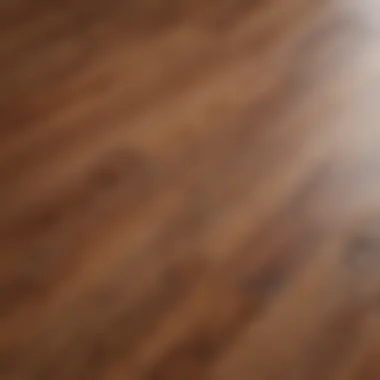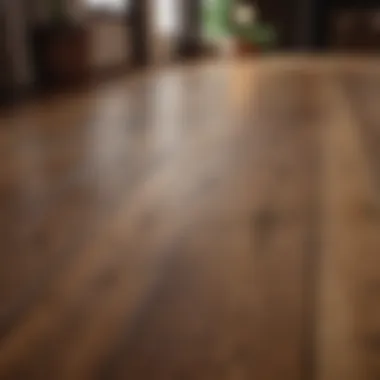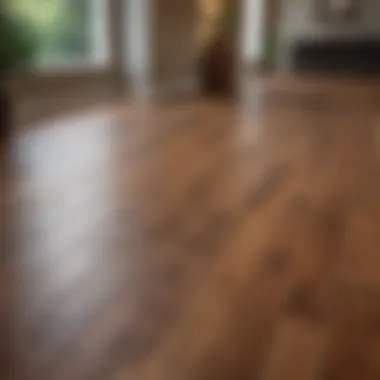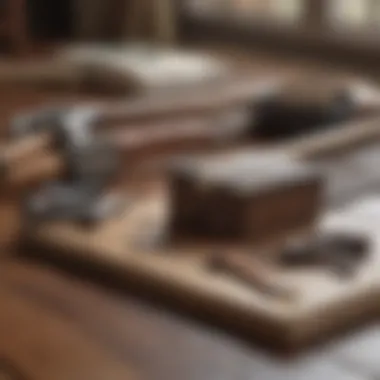Understanding the True Costs of Hardwood Flooring


Intro
Hardwood flooring often symbolizes elegance and durability, making it a popular choice among homeowners and design enthusiasts alike. However, the cost associated with it goes beyond just the price tag of the planks. Understanding the various factors that influence these costs is crucial for anyone considering hardwood as a flooring solution. This article aims to break down these expenses into manageable components, allowing prospective buyers to make informed decisions.
Key aspects will include an examination of different types of hardwood, their pricing structures, and installation variables. Furthermore, understanding the long-term value of hardwood compared to other flooring materials can provide insights into necessary budget considerations. The goal is to furnish readers with a solid comprehension of what influences hardwood flooring prices, thereby aiding in effective decision-making.
Design Inspirations
When it comes to choosing hardwood flooring, design inspiration plays a significant role. Consumer preferences continuously evolve, making it essential to stay updated on trending styles and color palettes.
Trending Styles
Currently, wide planks and matte finishes are gaining traction among style-conscious homeowners. In particular, styles that offer a rustic or reclaimed look continue to be appreciated for their unique character. Another emerging trend involves integrating mixed wood tones to create an eclectic and dynamic atmosphere in a space. These choices provide an effective way to personalize a home while maintaining elegance and sophistication.
Color Palettes
Selecting the right color palette is equally important for achieving your desired aesthetic. Warm tones like honey oak or deep walnut can create a cozy ambiance. On the other hand, cooler shades such as ash grey or white-washed oak often contribute to a more modern and airy feel. The decision ultimately impacts the overall design of a room, making it vital to consider how the chosen color will complement existing furnishings and décor.
"The right hardwood flooring can transform a room from ordinary to extraordinary, reflecting personal style and enhancing home value."
Maintenance and Upkeep
Understanding the maintenance required for hardwood flooring is crucial in preserving its beauty and extending its life. Regular care not only enhances aesthetics but also prevents costly repairs in the future.
Seasonal Maintenance Checklist
To maintain hardwood flooring effectively, consider implementing a seasonal checklist:
- Inspect for scratches or dents and address them promptly.
- During spring and fall, clean under furniture and between planks to remove debris.
- Regularly check humidity levels in your home and adjust accordingly to prevent warping.
Year-round, use area rugs in high-traffic zones to minimize wear and tear.
Cleaning and Organization Tips
When cleaning hardwood floors, using the correct products is essential. A microfiber mop can effectively pick up dust and dirt without harming the finish. Avoid water and traditional cleaning solutions, as excessive moisture can damage the wood. Instead, opt for cleaners specially formulated for hardwood surfaces. Additionally, organizing belongings in a way that limits friction on the floor can reduce scratches, ensuring the elegance of the flooring remains intact.
By diving deep into the intricacies of hardwood flooring costs, design inspirations, and maintenance, homeowners and design enthusiasts will be better positioned to make informed investment decisions.
Factors Influencing Hardwood Flooring Costs
Understanding the factors influencing hardwood flooring costs is critical for homeowners and design enthusiasts. Making informed decisions about flooring investments requires knowledge about different elements that affect pricing. These elements include the type of hardwood, quality and grade, species of wood, and current market trends.
Type of Hardwood
Solid Hardwood
Solid hardwood is a traditional choice for flooring. It consists of a single piece of wood, making it durable and long-lasting. Its key characteristic is that it can be sanded and refinished multiple times, enhancing its lifespan. This makes solid hardwood a popular choice for those who want longevity in their flooring.
However, wood expansion and contraction may pose a disadvantage in regions with fluctuating humidity; this can lead to gaps between planks.
Engineered Hardwood
Engineered hardwood is constructed of multiple layers, with a top layer of solid wood. This feature makes it more stable compared to solid hardwood, especially in humid environments. Its main benefit is its versatility in installation; it can be installed over various types of subfloors.
Nonetheless, engineered hardwood cannot be refinished as many times as solid hardwood, which may limit its lifespan.
Exotic vs. Domestic Options
Choosing between exotic and domestic hardwood is another consideration. Exotic woods, like Brazilian cherry, offer unique aesthetics with rich colors and grains that can elevate a space's design. These woods often come at a higher cost due to their rarity and sourcing challenges.
Domestic options, such as oak or maple, provide classic looks and are generally more affordable. However, the choice depends on individual preferences and budget constraints.
Quality and Grade
Select Grade
Select grade hardwood offers a refined appearance with minimal imperfections. Its quality is high, making it a favored choice for upscale projects. Select grade flooring ensures consistency in color and grain, adding to its appeal.


The downside is the higher price point compared to lower grades, which might deter budget-conscious consumers.
Common Grade
Common grade hardwood is more accessible and features variations in color and grain. It provides a rustic look, appealing to those who prefer character over uniformity. The main advantage of this grade is affordability.
Some aspects of common grade wood may be less desirable for high-end renovations, but its charm can fit cozy or casual spaces.
Character Grade
Character grade hardwood embraces knots, mineral streaks, and varied colors, making each plank unique. This grade is especially popular for adding warmth and a sense of history to interiors. Homeowners seeking distinctiveness may find this to be an excellent option.
However, the unevenness in appearance may not suit everyone's taste, leading some to prefer a more uniform look.
Wood Species
Oak
Oak is among the most sought-after hardwoods for flooring, known for its durability and hardness. Its ample grain patterns and variety of stains cater to a wide range of design preferences, making oak versatile. Additionally, it is readily available, contributing to its general affordability.
The primary drawback is its susceptibility to scratches, necessitating regular maintenance to maintain its appearance.
Maple
Maple hardwood is hard and resistant to wear, making it suitable for high-traffic areas. Its smooth grain and light color can brighten spaces. Maple is an attractive choice for modern designs.
However, it may be pricier than some domestic options and can be tricky to stain evenly due to its closed grain.
Hickory
Hickory is famed for its strength and shock-resistance. Its distinctive grain patterns add a rustic touch to homes. Hickory is often selected for its resilience and longevity, suited to heavy use.
Nevertheless, its varied color range may not suit everyone's taste, and it can be harder to work with during installation due to its density.
Market Trends
Supply Chain Issues
Supply chain problems can significantly impact hardwood flooring prices. Global disruptions may lead to delays in sourcing materials, creating scarcity in the market. This often results in higher costs for consumers.
Anticipating these fluctuations can help homeowners plan their purchases better, perhaps considering off-peak times to buy.
Demand Fluctuations
Demand for hardwood flooring often ebbs and flows. Renovation trends can spur increased interest, driving up prices. Conversely, a decrease in housing market activity may lead to lower prices.
Staying informed about these trends can aid in timing purchases wisely.
Seasonal Pricing
Seasonal changes can affect hardwood flooring prices as well. During the spring and summer months, demand tends to rise due to increased home renovation activity. This may lead to higher costs. On the other hand, autumn and winter might offer more competitive rates due to lowered demand.
By understanding these factors, homeowners can save significantly over time.
Average Costs of Hardwood Flooring
Understanding the average costs associated with hardwood flooring is crucial for homeowners and design enthusiasts. Prices can differ significantly based on factors like wood type, grade, and installation options. This section explores these costs, helping readers grasp how to budget for their flooring projects effectively.
Cost Per Square Foot
Standard Prices
Standard prices for hardwood flooring usually range between $3 to $12 per square foot. This wide range primarily involves the type of wood chosen and the quality of the materials. The key characteristic of standard prices is accessibility. Many homeowners find these prices to be manageable, allowing options suitable for various budgets.
Standard pricing also reflects the quality hierarchy within hardwood options. It makes it easier for potential buyers to make decisions based on cost and value. On the downside, lower-priced options may lack the durability and aesthetic appeal found in higher-grade options.
Premium Pricing Variations
Premium pricing for hardwood flooring can reach up to $20 or more per square foot. These prices are typically associated with high-quality wood species or particularly unique finishes. Premium variations offer several benefits, making them attractive for property owners seeking luxury aesthetics.


A unique feature of premium pricing is the potential for enhanced durability and longer lifespan, which may justify the higher upfront cost. This investment can be beneficial in high-traffic areas or homes that emphasize elegance. However, this option may not be suitable for all budgets, and careful planning is essential to avoid overspending.
Installation Costs
DIY Installation
DIY installation remains a favorite among homeowners looking to save on labor costs. One major aspect of DIY installation is the control it allows over the overall budget. Using personal skills, individuals can save about 50% or more compared to hiring a professional.
The primary advantage of DIY installation is the personal satisfaction of completing a project. However, not every homeowner is equipped to handle the task. A lack of skill can lead to improper installations, which can incur hidden costs later down the line, such as repairs.
Professional Installation Fees
When opting for professional installation, homeowners should expect fees ranging between $1.50 to $4 per square foot. Professional installation can alleviate concerns that arise during DIY projects, offering expertise and precision. This aspect enhances the overall value of the flooring project.
A unique benefit of professional installation is the warranty on workmanship, which can provide peace of mind. Still, the associated costs may not align with every homeowner’s budget. Engaging professionals can add a significant expense, making it vital to weigh the long-term benefits against immediate costs.
Comparative Cost Analysis: Hardwood vs. Other Flooring Options
Analyzing the costs of hardwood flooring in comparison to other options is crucial for homeowners making well-informed decisions. Understanding how hardwood stacks up against laminate, vinyl, and carpet not only helps in budgeting but also in assessing long-term value. Each flooring type has its unique advantages and challenges, which can significantly impact a homeowner's choice.
Laminate Flooring
Cost Overview
Laminate flooring offers a more affordable alternative to hardwood. Typically, laminate costs range from $1 to $5 per square foot, depending on the brand and quality. The key characteristic of laminate flooring is its ease of installation and resistance to moisture, making it a popular choice for busy households.
The affordability is a unique aspect of laminate. This can reduce initial project costs significantly. However, the lower price often goes hand-in-hand with shorter lifespan and reduced aesthetic appeal when compared to hardwood.
Durability Considerations
Durability is another essential factor for laminate flooring. While it resists scratches and dents better than hardwood, it can still be susceptible to water damage if it is not sealed properly. Many homeowners appreciate this feature due to its potential to endure heavy foot traffic. This makes laminate versatile for areas of the home where traditional hardwood might not perform as well. On the downside, once laminate is damaged, it cannot be refinished like hardwood.
Vinyl Flooring
Pricing Comparison
Vinyl flooring usually ranges from $2 to $8 per square foot. It is an economical flooring option, and many designs can closely mimic natural wood finishes. The pricing makes vinyl a beneficial choice for those seeking attractive flooring without the hardwood price tag. Its flexibility and variety of designs provide homeowners multiple choices to match their home decor. However, some may find that lower-cost vinyl does not offer the same visual warmth as hardwood.
Maintenance Costs
Regarding maintenance, vinyl flooring is straightforward and wallet-friendly. Regular cleaning is the primary requirement, without the need for seasonal refinishing or polishing unlike many hardwood options. This could lead to significant savings over time. The downside, however, is that vinyl can wear down and may need replacement sooner than hardwood, leading to additional costs of reinvestment.
Carpet
Initial Investment
The cost of carpet installation varies significantly but often falls between $2 to $4 per square foot. Carpets provide a soft flooring option that is inviting and warm, especially in colder climates. Homeowners appreciate the comfort and insulation that carpets can provide, making it a favorable choice for bedrooms and living areas. However, the initial investment in quality carpet could be overshadowed by its shorter lifespan when compared to hardwood.
Long-Term Value
When assessing long-term value, carpet does not hold up as well as hardwood. While the initial costs may be lower, quality carpets generally require replacement every 5 to 10 years, depending on the wear. In contrast, well-maintained hardwood can last for generations, often appreciating in value. This long-term investment perspective is a critical factor for homeowners considering future resale value when selecting their flooring options.
In summary, comparing the costs of hardwood flooring with other options like laminate, vinyl, and carpet provides a comprehensive understanding that helps in decision-making. Each flooring type has its merits and limitations that must be evaluated in terms of initial costs, durability, and long-term value.
Long-Term Cost Considerations
Understanding long-term cost considerations is critical for homeowners contemplating hardwood flooring. This aspect delves into costs beyond the initial investment, focusing on maintenance, durability, and how these factors influence the overall value of your flooring choice.
Maintenance Expenses
Refinishing Costs
Refinishing hardwood floors can become necessary after several years of heavy use. This process involves sanding down the surface and applying a new finish, enhancing the floor's appearance and longevity. Refinishing costs vary, typically ranging between $2 to $5 per square foot.
The key characteristic of refinishing is that it rejuvenates the floor without requiring a complete replacement. This process can be beneficial as it can bring back the original beauty of the wood, greatly extending its life. However, it's important to note that not all hardwoods can be refinished multiple times; softer woods may wear down quicker and require more frequent care.
In this article, the unique feature of refinishing lies in its potential to save homeowners money over the long run compared to replacing flooring outright. Thus, understanding when and how to refinish can directly influence your buying decision.
Cleaning and Upkeep


Cleaning and upkeep of hardwood floors are essential for maintaining their aesthetic appeal and integrity. Maintaining hardwood requires specific products, and the costs can add up over time. Regular sweeping and occasional mopping with appropriate cleaners help prolong the life of the floor. Cleaning and upkeep can be relatively low-cost, depending on the products used.
One notable advantage of hardwood is its resistance to stains and spills when properly sealed. However, the maintenance can be intensive, especially if dirt and debris are not regularly addressed, which can lead to scratches requiring more expensive refinishing.
Resale Value
Impact on Home Value
Investing in hardwood flooring can significantly influence your home’s resale value. Well-maintained hardwood can offer a return on investment of around 70% to 80% when it comes time to sell the property. The key characteristic of this flooring type is its widespread appeal among buyers, making it a popular choice that enhances marketability.
The unique feature of this investment is that hardwood floors tend to withstand fluctuations in market preferences. They don’t go out of style as easily as other materials might, ensuring enduring value.
Market Trends Analysis
In terms of market trends, understanding the fluctuations in hardwood pricing can provide insight into future resale value. The popularity of hardwood varies with home design preferences and economic factors. Current trends show an increasing demand for sustainable and engineered options, influencing market pricing.
The advantage of being aware of these trends is that it enables homeowners to time their investments better. For example, purchasing hardwood while the prices are lower could enhance long-term financial benefits.
In summary, long-term cost considerations rely heavily on maintenance and resale dynamics. By evaluating the implications of costs associated with upkeep and appreciating the financial return at resale, homeowners can make informed decisions that align with their long-term financial goals.
Financial Planning for Hardwood Flooring Projects
Financial planning is crucial when considering hardwood flooring for your home. This process involves budgeting and exploring financing options, both of which can significantly affect your project's overall cost. Homeowners should understand that proper financial planning can prevent overspending and help avoid unexpected expenses. This section will explore various elements related to planning finances for flooring projects, outlining key benefits and considerations.
Budgeting
Creating a Flooring Budget
Creating a flooring budget is the first step in financial planning. It provides a clear framework for understanding how much you can spend on hardwood flooring. This budget encompasses materials, installation costs, and essential additional items such as underlayment or transition strips.
The main characteristic of creating a flooring budget is its ability to set realistic expectations. It helps homeowners align their desires with their financial capabilities. This proactive approach is a beneficial choice because it reduces stress during the selection process.
A unique feature of this budgeting process is that it encourages thorough research into different hardwood options and their respective costs. This allows homeowners to make informed decisions. However, if the budget is too rigid, it might limit choices significantly, leading to dissatisfaction with the final selection.
Contingency Planning
Contingency planning is another essential aspect of financial preparation. It accounts for unforeseen circumstances that could arise during your hardwood flooring project, such as unexpected damage or changes in material prices.
Its key characteristic is flexibility. By setting aside a portion of your budget for contingencies, you ensure that you are prepared for emergencies without derailing the entire project’s financial structure. This makes contingency planning a wise decision.
One notable feature of having a contingency fund is that it fosters peace of mind. Knowing you have a safety net can offer comfort during the renovation process. However, the downside may include allocating a portion of the budget that could have gone towards improved materials or features.
Financing Options
Loan Considerations
When considering hardwood flooring, exploring loan options can be a viable financial strategy. Many homeowners opt for loans to spread out costs over time, making high-quality flooring more accessible.
The main characteristic of loan considerations is their potential to offer flexibility in payments. Loans can help manage cash flow, allowing homeowners to undertake flooring projects without immediate financial strain. This makes it a popular choice for many.
A unique benefit of taking out a loan is the ability to select higher-quality materials. However, this path also brings risks related to interest rates and long-term repayment obligations that can add financial pressure if not managed properly.
Payment Plans
Payment plans are another alternative that homeowners can utilize. Many flooring retailers offer flexible payment options that allow customers to pay over time instead of upfront costs. This can make hardwood flooring more financially feasible.
The key feature of payment plans is their structure, which typically involves manageable monthly payments. This can ease immediate out-of-pocket expenses, which is a beneficial choice for many buyers.
However, payment plans often come with fine print regarding interest rates or fees. Homeowners should carefully review these details to avoid unexpected costs. Ensuring clarity in these agreements is critical to maintaining budgetary control.
Epilogue: Informed Decision Making
In the realm of home improvement, making educated choices is crucial, especially regarding flooring. This article aims to equip homeowners and interior design enthusiasts with the necessary insights to navigate the complexities of hardwood flooring costs. By understanding various aspects such as types of hardwood, quality variations, and installation fees, readers can avoid common pitfalls that may arise from impulsive decisions.
A well-informed conclusion should take into account factors like long-term value, maintenance expenses, and resale potential. Hardwood flooring is not merely an aesthetic choice; it is also a financial commitment. Therefore, analyzing expenses over time is essential when determining if this investment aligns with individual budget constraints.
Benefits of having a structured financial plan include:
- Clarity in Budgeting: Establishing a precise budget allows for a clearer vision of what can be achieved. It prevents overspending and ensures that every aspect of the flooring project is feasible.
- Understanding of Financing Options: Knowing available financing methods can alleviate stress related to upfront costs. This makes it easier to adjust to broader financial implications in the face of other home improvement initiatives.
- Accurate Assessment of Long-Term Costs: A focus on maintenance needs and potential future refinishing requirements helps in evaluating the overall cost of ownership. Buyers often overlook these details, which can lead to unexpected burdens later.
Moreover, grasping market trends can provide leverage in negotiations. Homeowners should consider if supply chain issues might affect pricing in the near future. Understanding when to buy and how to plan for price fluctuations can offer significant savings.
"The key to successful investment in hardwood flooring lies in understanding its multifaceted nature—from costs to potential returns."
As buyers reflect on their choices, they should remember that knowledge is power. Each decision should be backed by thorough research and clear consideration of the implications. By following the guidelines presented throughout this article, individuals can intelligently approach their hardwood flooring needs, ensuring a satisfying result that enhances both their home environment and financial standing.







